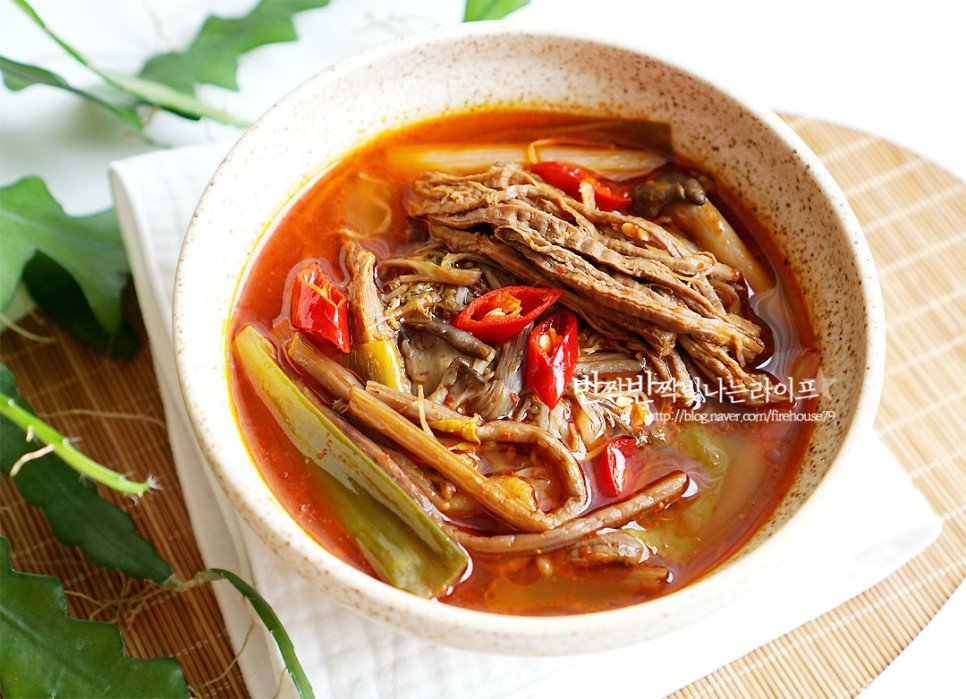Spicy and Rich Beef Yukgaejang Recipe
Make Hearty Beef Yukgaejang at Home!

Enjoy a hearty and rich bowl of Beef Yukgaejang, a beloved Korean classic, right in your own kitchen! This soul-warming soup features tender, slow-cooked beef, paired with nutritious fernbrake (gosari), taran root (torandae), oyster mushrooms (neutari beoseot), crisp bean sprouts (sookju), and plenty of scallions (daepa) for a refreshing taste. Generously packed with ingredients and simmered to perfection, this Yukgaejang delivers a deep, savory umami and a spicy kick that will have you devouring a bowl of rice without any side dishes. The blend of various vegetables and succulent beef creates an exceptionally rich and profound flavor. Perfect for special occasions or a satisfying meal, make this delicious Yukgaejang today!
Main Ingredients- 400g Beef Brisket (Yangji-meori)
- 220g Cooked Fernbrake (Gosari)
- 170g Cooked Taro Stems (Torandae)
- 300g Bean Sprouts (Sookju)
- 300g Oyster Mushrooms (Neutari Beoseot)
- 3 Scallions (Daepa)
- 1 Onion (Yangpa)
- 1/5 piece Radish (Moo)
Cooking Instructions
Step 1
Start by preparing the beef brisket, the star of Yukgaejang. Soak it in cold water for about 30 minutes to remove any excess blood. Properly draining the blood ensures a clear and clean-tasting broth without any gamey odors.

Step 2
In a pot, combine the drained beef, 2L of water, one whole scallion, one onion, and the piece of radish. Bring to a boil over high heat, then reduce to medium heat and simmer for about 1 hour until the beef is tender and the broth is flavorful. This process tenderizes the meat and extracts a rich, delicious broth.

Step 3
Wash the oyster mushrooms thoroughly under running water. Bring a pot of water to a boil with a pinch of salt, and blanch the oyster mushrooms for just 1-2 minutes. Be careful not to overcook them, as they can become mushy.

Step 4
Prepare the bean sprouts similarly. In boiling water with a pinch of salt, quickly blanch the bean sprouts just until they soften slightly. Maintaining their crispness is key.

Step 5
Cut the pre-cooked fernbrake and taro stems into bite-sized pieces, about 1cm wide. Discard any tough parts and use only the tender sections.

Step 6
Chop the remaining two scallions roughly into 4-5cm lengths. Large pieces add a satisfying texture and release their refreshing flavor into the broth.

Step 7
In a large bowl, combine the chopped fernbrake, taro stems, blanched bean sprouts, and blanched oyster mushrooms.

Step 8
Season the vegetables in the bowl. Add 3 Tbsp Gochugaru, 2 Tbsp soup soy sauce, 1 Tbsp sesame oil, and 1 Tbsp minced garlic. Mix well to coat the vegetables evenly.

Step 9
Gently toss and massage the vegetables with the seasoning to ensure the flavors meld beautifully. This initial seasoning enhances the individual tastes of each ingredient.

Step 10
Carefully strain the broth from the pot where the beef was simmered, discarding the boiled vegetables and aromatics. You want to keep only the clear, flavorful broth. A clean broth is the foundation of great Yukgaejang.

Step 11
Remove the cooked beef from the pot and let it cool slightly. Then, shred the beef along the grain into bite-sized pieces. Shredding them to a moderate size, rather than too finely, will provide a better eating experience.

Step 12
Season the shredded beef as well. Add 1 Tbsp Gochugaru, 1 Tbsp soup soy sauce, 1 Tbsp cooking wine, and 1/2 Tbsp sesame oil. Gently mix and massage to marinate the beef.

Step 13
Now it’s time to bring everything together. Pour the strained broth into a large pot. Add all the seasoned vegetables and the shredded beef. Finally, add the roughly chopped scallions.

Step 14
For an extra layer of spicy depth and vibrant color, add about 3 Tbsp of chili oil. This will enhance the chili flavor and give the soup a beautiful red hue.

Step 15
Bring the soup to a boil over high heat, then reduce to medium-low heat and simmer gently for 30 minutes to 1 hour. The longer it simmers, the deeper and richer the flavors will become. For extra heat, you can add chopped chili peppers or more Gochugaru. Adjust the final seasoning with soup soy sauce or salt, and sprinkle a little black pepper just before serving for aroma. You can also add a raw egg for a richer soup if you like.

Step 16
The generously filled Yukgaejang will be a visually appealing and incredibly satisfying dish. A hearty serving of ingredients makes the eating experience twice as enjoyable. This warm and spicy bowl of Yukgaejang is so flavorful that you won’t need any other side dishes to enjoy a bowl of rice. Enjoy a hearty and delicious meal!



